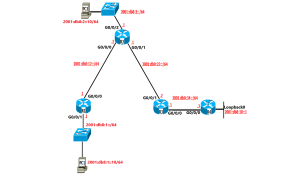
This lab covers IPv6 static and static default routes. Static routes are a manual way of defining the path a packet should take in the network to get to its destination. The command to write an IPv6 static route is similar to an IPv4 static route except you use the command IPv6 route instead of ip route static route is ipv6 route destination prefix destination prefix/prefix length [outgoing interface | next hop IP address]. In regular terms after the ipv6 route portion of the command it is where does the packet need to go and how is it going to get there. An administrative distance can be added to the end of the ipv6 route command, but we will use that later in a “Floating Static Routes” lab example.
A static route can be written using the outgoing interface, next-hop address, or both based upon your needs. In this lab we will use outgoing interface or next-hop address (address of forwarding router) in the examples just as examples, for no particular reason.
Before you start the static route configuration given, configure the router hostnames, IP addressing, and activate the interfaces. The Switches and PCs aren’t required, you can do an extended ping from the inside router interfaces (LAN interfaces) to the other addresses to test your routing. If you want to use the PCs but not the switches you can connect the PCs without Switches directly to the router.
This lab is similar to the IPv4 Static Routes lab except we will be doing IPv6 routes.
We will begin with router R1 and work our way through the topology with static and static default routes to configure the static routing.
IPv6 Static Routes
R1
The first route in the list will use next-hop address, the second route will use outgoing interface, and the third route will use both outgoing interface and next-hop address. A route using both the interface and next-hop address is referred to as a fully specified route. We are configuring the routes three different ways just as examples of what you can do. Routes using next-hop address are usually used in broadcast networks, when the other end of the link could have multiple addresses and routes using outgoing interface are typically used on point-to-point networks.
R1(config)# ipv6 route 2001:db8:2::/64 2001:db8:12::2
R1(config)# ipv6 route 2001:db8:23::/64 g0/0/0
R1(config)# ipv6 route 2001:db8:34::/64 g0/0/0 2001:db8:12::2
R1(config)# ipv6 route 2001:db8:10::/64 2001:db8:12::2
R2
R2(config)# ipv6 route 2001:db8:1::/64 2001:db8:12::1
R2(config)# ipv6 route 2001:db8:34::/64 2001:db8:23::2
R2(config)# ipv6 route 2001:db8:10::/64 2001:db8:23::2
R3
R3(config)# ipv6 route 2001:db8:2::/64 2001:db8:23::1
R3(config)# ipv6 route 2001:db8:12::/64 2001:db8:23::1
R3(config)# ipv6 route 2001:db8:1::/64 2001:db8:23::1
R3(config)# ipv6 route 2001:db8:10::/64 2001:db8:34::2
R4
On R4 configure an IPv6 static default route to send packets to all the routes on R1-R3. A default route is used to forward all traffic the router doesn’t have a better route for. In a sense the route below says “any packets the router doesn’t know how to forward out R4’s g0/0/0 interface“.
R4(config)#ipv6 route ::/0 g0/0/0